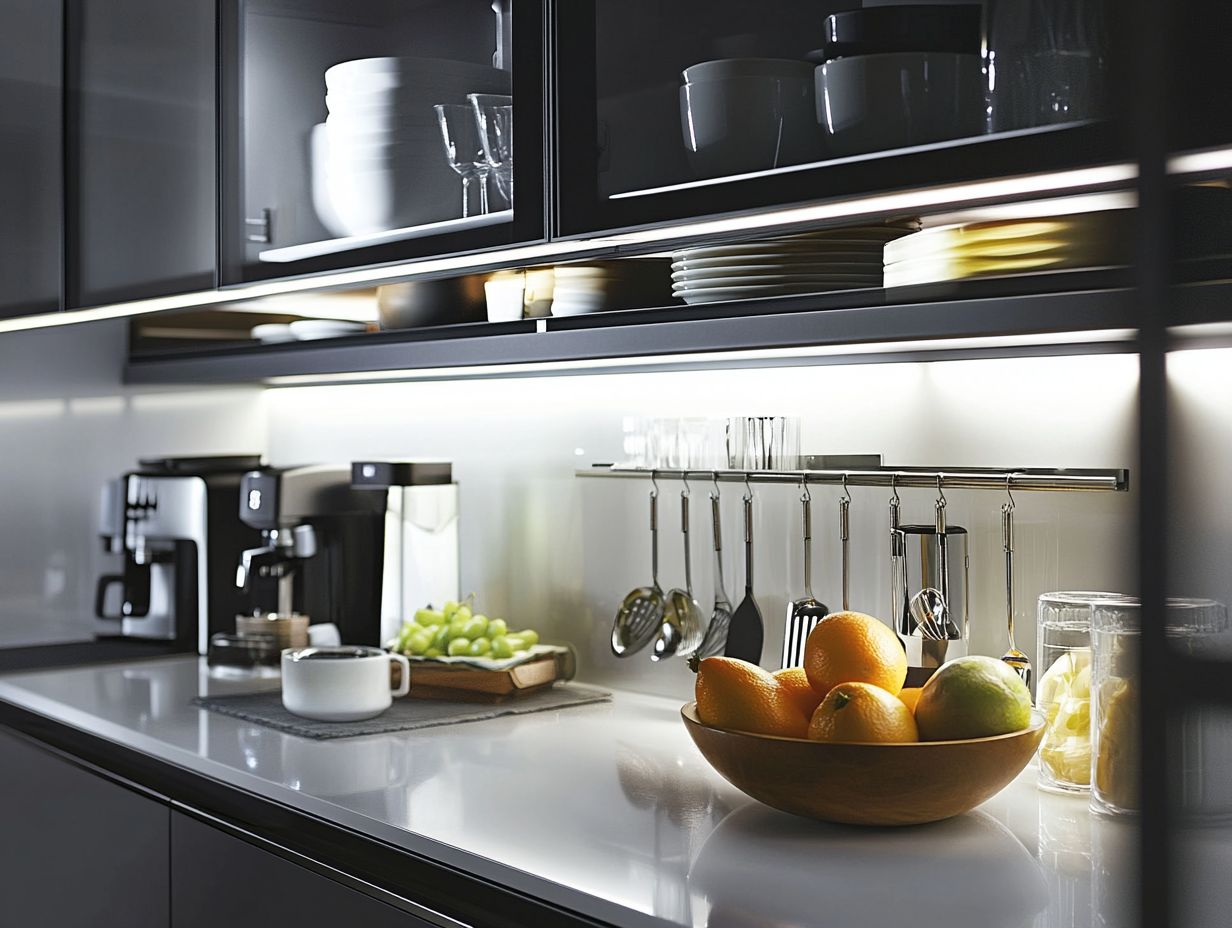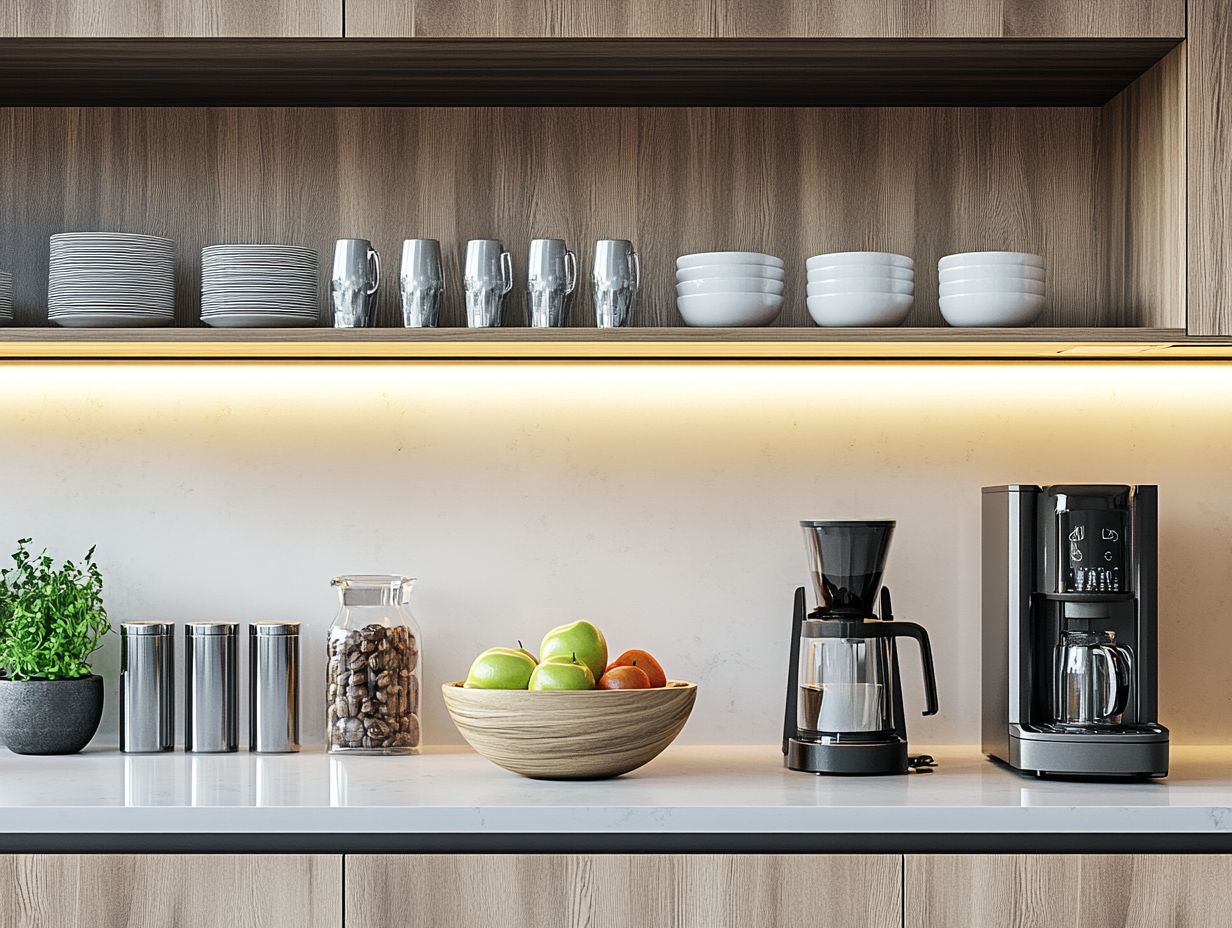The Role of Cabinets in Kitchen Functionality
Kitchens truly serve as the heart of your home, and the cabinets are integral to both their functionality and visual allure.
The right cabinets not only provide essential storage solutions but also enhance the overall design of your cooking space, transforming it into something special.
This article delves into various cabinet types, materials, and styles. You’ll find valuable tips for maximizing storage and customizing designs to suit your unique preferences.
You’ll also discover best practices for maintaining your cabinets, ensuring they remain stylish and functional for years to come.
Don’t miss out—discover how the right cabinets can transform your kitchen today!
Contents
- Key Takeaways:
- The Importance of Cabinets in the Kitchen
- Types of Kitchen Cabinets
- Maximizing Cabinet Space
- Customizing Cabinets for Your Needs
- Maintaining and Cleaning Cabinets
- Frequently Asked Questions
- What is the role of cabinets in kitchen functionality?
- How do cabinets impact the overall design of a kitchen?
- What factors should be considered when choosing kitchen cabinets?
- How can cabinets maximize kitchen functionality?
- Are there different types of cabinets available for different kitchen layouts?
- How can I maintain the functionality of my kitchen cabinets?
Key Takeaways:

Properly chosen cabinets enhance both the functionality and aesthetics of a kitchen space, making it more efficient and visually appealing.
There are various types of kitchen cabinets, each allowing for customization to suit individual preferences and needs.
Efficient storage is key to keeping your kitchen organized and clutter-free.
The Importance of Cabinets in the Kitchen
Cabinets play a vital role in your kitchen design, serving as essential storage solutions and shaping the overall aesthetics and efficiency of your culinary space.
They form the backbone of a well-organized kitchen layout, helping you optimize functionality while incorporating custom cabinetry that reflects your personal style.
In today’s modern kitchen trends, functional cabinets have evolved into ergonomic storage options, making them essential for any remodeling endeavor.
Functionality and Aesthetics
Kitchen cabinets serve as both functional storage and striking focal points of design.
When you carefully design your cabinets, you’re not just optimizing space; you’re elevating the entire design theme of your kitchen.
Innovative storage options—such as pull-out shelves, lazy Susans, and deep drawers—ensure that every inch of space is used effectively, making it easier to reach what you need while still looking stylish.
Consider your cabinet layout; an open-concept design with shaker-style cabinets fosters a warm atmosphere, while a galley-style layout enhances efficiency during meal prep.
Embracing popular styles like farmhouse, contemporary, or traditional cabinets adds unique charm, redefining both character and functionality.
Types of Kitchen Cabinets
Knowing about different kitchen cabinet types helps you make smarter design choices.
Each style and material offers unique advantages, allowing you to create a space that reflects your vision and meets your functional needs.
Overview of Different Styles and Materials

Kitchen cabinets come in a stunning array of styles and materials, from the warmth of traditional wood to the sleek allure of metal finishes and vibrant modern laminate.
Traditional wood cabinets radiate warmth and timeless charm, perfect for classic or rustic designs. However, they may require more upkeep over time.
Laminate cabinets provide a budget-friendly solution with eye-catching colors and patterns, popular for contemporary designs. Yet, they may lack the durability or refined appearance of higher-end materials.
Sleek metal finishes can infuse a bold, industrial vibe into modern kitchens. Remember, they might clash with more traditional styles due to their stark appearance.
By weighing these pros and cons, you can make informed decisions that align with your kitchen’s overall style and functionality, ensuring a space that feels just right for you.
Maximizing Cabinet Space
Maximizing your cabinet space is essential for efficient storage solutions in your kitchen.
Innovative design elements can significantly enhance your storage capacity.
Tips for Efficient Storage
Implementing smart tips for efficient storage can elevate your kitchen cabinet usage, transforming your cooking space into a model of organization.
By introducing solutions such as pull-out drawer bases instead of traditional shelves, you can maximize every inch of available space.
Consider incorporating shelves that stack up to streamline access to spices and canned goods, making sure you find everything quickly without any hassle!
Utilizing clear bins or labeled containers can also help sort similar items, reducing clutter and making everything easier to locate.
Think creatively about floating shelves for frequently used utensils or magnetic strips for knives to enhance both the functionality and aesthetic appeal of your kitchen.
Customizing Cabinets for Your Needs
Customizing cabinets gives you the power to design your kitchen according to your unique needs and preferences, seamlessly merging functionality with personal style.
This approach transforms your cooking space into a truly distinctive environment, reflecting your individuality while enhancing everyday usability.
Designing for Specific Purposes and Preferences

When you design cabinets tailored to your specific needs and tastes, you can create a kitchen that is not just functional but also a true reflection of your personal style.
By exploring various cabinet design strategies—like optimizing space for your cooking utensils, incorporating compartments for small appliances, or integrating dedicated slots for fresh herbs—you can bring your vision to life.
For instance, pull-out shelves can effortlessly accommodate bulky items like mixers or blenders, keeping them accessible while maintaining a clutter-free countertop.
Vertical storage solutions for pots and pans can maximize efficiency, and drawer dividers for utensils can bring a much-needed sense of order to the chaos.
This level of attention to detail enhances usability and perfectly aligns your cabinetry with the culinary activities that take place in the heart of your home.
Maintaining and Cleaning Cabinets
Proper maintenance and cleaning of kitchen cabinets are essential practices that can significantly enhance their lifespan and preserve their aesthetic charm.
By investing time in these tasks, you ensure that your cabinets remain functional and visually appealing for years to come.
Best Practices for Longevity and Hygiene
Implementing best practices for the longevity and care of your kitchen cabinets is essential to preserving their beauty and functionality over time.
Regular cleaning is key; a simple blend of warm water and mild dish soap works wonders for daily maintenance.
For pesky stubborn stains, reach for a gentle all-purpose cleaner specifically formulated for wood or laminate surfaces.
Establishing a maintenance schedule with deeper cleanings every few months will help you avoid grime buildup and potential damage.
It is wise to regularly inspect your cabinets for any signs of wear, such as loose hinges or fading finishes.
Tackling these issues promptly with quality products like wood polish or oil can significantly enhance their resilience and appearance, ensuring that your cabinets remain a stunning focal point in your kitchen.
Frequently Asked Questions
What is the role of cabinets in kitchen functionality?

Cabinets are key for keeping your kitchen organized and functional. They help maintain a clutter-free space and provide a surface for countertop appliances.
How do cabinets impact the overall design of a kitchen?
Cabinets play a major role in the aesthetic of a kitchen, as they are typically the largest and most prominent feature in the space. They set the tone for the style and color scheme, greatly enhancing the overall design.
Ready to transform your kitchen? Start your cabinet makeover today!
What factors should be considered when choosing kitchen cabinets?
When selecting cabinets for your kitchen, consider the space you have, your storage needs, and your budget. Personal style is also crucial, along with the quality and durability of the materials used.
How can cabinets maximize kitchen functionality?
Cabinets increase functionality by offering ample storage and keeping your kitchen organized. They can be customized with shelves that slide out and storage solutions built into the cabinet for added convenience.
Are there different types of cabinets available for different kitchen layouts?
Yes, many cabinet types are designed for various kitchen layouts. There are options specifically made for corner spaces, islands, and galley kitchens.
How can I maintain the functionality of my kitchen cabinets?
Keep your cabinets clean and decluttered to maintain functionality. Regularly inspect for damages, like loose hinges or handles, to ensure everything continues to work smoothly.





